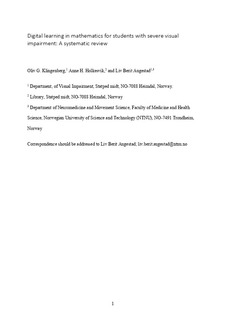Digital learning in mathematics for students with severe visual impairment: A systematic review
Journal article, Peer reviewed
Accepted version
Permanent lenke
http://hdl.handle.net/11250/2626773Utgivelsesdato
2020Metadata
Vis full innførselSamlinger
Sammendrag
Mathematical education is currently undergoing significant changes that are driven by technology and digital-based learning. Students with visual impairments (VI) may face different challenges in mathematical education due to a lack of accessible materials designed to support the development of conceptual understanding in mathematics. The aim of the study was to summarize current evidence-based knowledge about e-learning in mathematics among students with severe VI. A systematic review was conducted of articles published from January 2000 to November 2017. A total of 13 publications met the inclusion criteria, of which 12 reported studies with an intervention or an experimental design and one had a cross-sectional design. The number of students with VI varied from three to 16 (Mage = 19 years). Four publications reported either ophthalmic diagnoses or World Health Organization’s (WHO) definition of vision loss. The mathematical training was reported as lasting from one session to 18 weeks of training. Eight papers reported the use of audio-based applications as learning aids. The authors conclude that interactive e-learning with audio and tactile learning programmes may be a useful resource for students with VI to enhance their mathematical skills. However, there is lack of evidence for how digital technologies improve inclusion potentials and learning in mathematics for students with VI, and hence, there is a need for additional research and more reflection on the subject.
